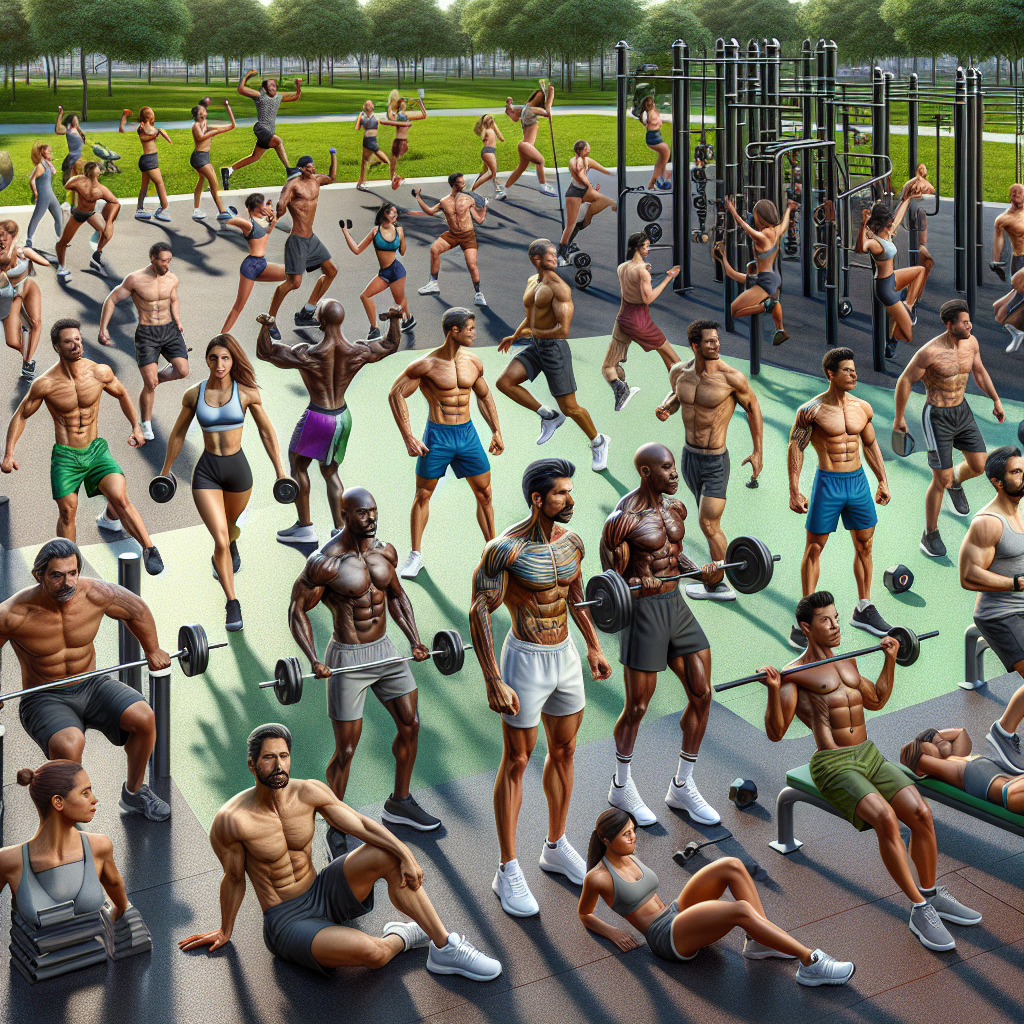
For many, the journey to achieving peak physical health is a deeply personal one, filled with highs, lows, and everything in between. Fitness enthusiasts are individuals who have committed themselves to this journey, striving for continuous improvement in strength, endurance, and overall well-being. Whether you’re a seasoned athlete or just starting, understanding the core principles of fitness can make a significant difference in your progress.
At its core, being a fitness enthusiast means more than just hitting the gym regularly. It encompasses a holistic approach that includes proper exercise routines, balanced nutrition, and effective recovery techniques. This article will delve into expert tips designed to elevate your fitness routine, ensuring you get the most out of every workout.
So, what sets apart a fitness enthusiast from a casual gym-goer? It’s the dedication to consistently pushing boundaries, experimenting with new techniques, and staying informed about the latest advancements in the fitness world. By integrating these elements, you can transform your workouts and achieve results that go beyond mere physical appearance.
If you’re ready to take your fitness journey to the next level, stay tuned. Explore More at Muscle Theory for in-depth insights and expert advice tailored to fitness enthusiasts like you.
Setting Realistic Fitness Goals

One of the cornerstones of any successful fitness journey is setting realistic and achievable goals. For fitness enthusiasts, this means creating targets that are not only ambitious but also grounded in reality. Unrealistic goals can lead to frustration and burnout, whereas realistic ones can provide a clear path to success and sustained motivation.
Start by defining what success looks like for you. Is it losing a certain amount of weight, gaining muscle mass, improving cardiovascular health, or perhaps enhancing overall flexibility? Once you’ve identified your primary objective, break it down into smaller, manageable milestones. This approach allows you to track progress incrementally and celebrate small victories along the way.
It’s also crucial to set both short-term and long-term goals. Short-term goals might include weekly workout targets or monthly strength gains, while long-term goals could focus on larger achievements like completing a marathon or reaching a specific body fat percentage. By diversifying your goals, you can maintain a balanced and comprehensive fitness regimen.
Moreover, ensure your goals are SMART: Specific, Measurable, Achievable, Relevant, and Time-bound. For instance, instead of saying “I want to get stronger,” specify “I aim to increase my bench press by 20 pounds in the next three months.” This clarity can significantly enhance your focus and determination.
Finally, remember that flexibility is key. Life happens, and sometimes goals need to be adjusted. Regularly reassess your progress and make necessary modifications to stay on track without feeling overwhelmed. By setting realistic fitness goals, you lay the groundwork for sustained success and continuous improvement.
Incorporating Strength Training

Strength training is a pivotal component of any well-rounded fitness routine, especially for fitness enthusiasts looking to elevate their performance. Incorporating strength training into your regimen not only helps build muscle mass but also enhances overall physical strength, boosts metabolism, and improves bone density.
To effectively incorporate strength training, start by understanding the basic principles. Strength training involves exercises that use resistance to induce muscular contraction, which can be achieved through free weights, resistance bands, or body weight exercises. Key movements include squats, deadlifts, bench presses, and rows, which target multiple muscle groups simultaneously.
Begin with compound exercises that work several muscle groups at once. These exercises are efficient and effective, providing a solid foundation for strength and muscle growth. For example, squats and deadlifts are excellent for engaging the lower body and core, while bench presses and rows target the upper body. As you become more comfortable with these movements, gradually incorporate isolation exercises to focus on specific muscles.
It’s essential to maintain proper form to prevent injury and maximize benefits. Consider consulting with a fitness professional or utilizing resources like instructional videos to learn correct techniques. Additionally, start with lighter weights to master the form before progressively increasing the load. This method, known as progressive overload, is crucial for continuous improvement and muscle adaptation.
Equally important is allowing adequate recovery between strength training sessions. Muscles need time to repair and grow, so aim for at least 48 hours of rest for each muscle group. Incorporate stretching and foam rolling into your routine to aid recovery and maintain flexibility.
By strategically incorporating strength training into your fitness routine, you’ll not only build a stronger, more resilient body but also enhance your overall athletic performance.
Optimizing Nutrition for Performance

For fitness enthusiasts, optimizing nutrition is key to enhancing performance and achieving workout goals. Proper nutrition fuels your body, aids in recovery, and supports muscle growth. Here are some tips to help you optimize your diet for peak performance.
1. Prioritize Protein Intake: Protein is essential for muscle repair and growth. Aim to include a source of protein in every meal and snack. Good options include lean meats, fish, eggs, dairy products, legumes, and plant-based protein sources like tofu and tempeh.
2. Balance Carbohydrates: Carbohydrates are the primary energy source for high-intensity workouts. Choose complex carbohydrates such as whole grains, fruits, and vegetables, which provide sustained energy. Timing your carb intake around your workouts can help boost performance and recovery.
3. Healthy Fats: Don’t shy away from healthy fats, as they play a crucial role in hormone production and energy. Include sources like avocados, nuts, seeds, and olive oil in your diet. These fats can also help you feel fuller for longer, preventing overeating.
4. Stay Hydrated: Hydration is often overlooked but is vital for maintaining performance. Water is essential for regulating body temperature, transporting nutrients, and removing waste. Aim for at least 8-10 glasses of water a day, and increase intake based on your activity level and climate conditions.
5. Micronutrients Matter: Vitamins and minerals support various bodily functions, including muscle contraction and energy production. Ensure a varied diet rich in fruits, vegetables, nuts, and seeds to meet your micronutrient needs.
6. Timing and Portion Control: When you eat is almost as important as what you eat. Consuming a balanced meal with protein, carbs, and fats 2-3 hours before a workout can provide sustained energy. Post-workout, aim for a meal or snack rich in protein and carbs within 30-60 minutes to kickstart recovery.
By focusing on these nutritional strategies, fitness enthusiasts can maximize their performance, improve recovery, and achieve their fitness goals more effectively. Remember, consistency is key, and making small, sustainable changes can lead to significant improvements over time.
Importance of Rest and Recovery
For fitness enthusiasts, rest and recovery are just as crucial as the workouts themselves. While it may be tempting to push your limits constantly, giving your body the time it needs to heal and rejuvenate is essential for long-term success and injury prevention.
1. Muscle Repair: Intense workouts cause micro-tears in muscle fibers, which need time to repair and grow stronger. Adequate rest allows this process to occur, leading to muscle hypertrophy and improved strength.
2. Preventing Overtraining: Overtraining can lead to fatigue, decreased performance, and even injury. It’s vital to listen to your body and incorporate rest days into your routine to avoid burnout and keep your workouts effective.
3. Mental Health: Continuous training without breaks can lead to mental fatigue and decreased motivation. Rest days help to recharge your mind, reduce stress, and keep your fitness journey enjoyable.
4. Sleep: Quality sleep is a cornerstone of effective recovery. During sleep, your body releases growth hormones that aid in muscle repair and overall recovery. Aim for 7-9 hours of sleep per night to support your fitness goals.
5. Active Recovery: Not all rest days have to be entirely inactive. Activities like light walking, stretching, or yoga can promote blood flow and aid in recovery without putting additional strain on your muscles.
6. Nutrition: Recovery isn’t just about rest; it’s also about fueling your body with the right nutrients. Ensure you’re consuming enough protein, healthy fats, and carbohydrates to support muscle repair and replenish energy stores.
7. Hydration: Staying hydrated is essential for recovery. Water helps transport nutrients to cells and remove waste products, facilitating quicker recovery times. Incorporate electrolyte-rich beverages if you’re engaging in prolonged, intense exercise.
By prioritizing rest and recovery, fitness enthusiasts can enhance their performance, reduce the risk of injury, and maintain a healthy, sustainable workout routine. Remember, progress is made not only in the gym but also during the times you allow your body to rest and recover.
Tracking Progress and Staying Motivated

Tracking your progress and staying motivated are key components for any fitness enthusiast aiming to elevate their routine. Without a clear method to measure your achievements and maintain enthusiasm, it can be challenging to stay on track and reach your goals.
1. Set Specific Goals: Start by defining what you want to achieve. Whether it’s losing weight, building muscle, or improving stamina, having specific, measurable goals will give you a clear direction and purpose.
2. Use Fitness Apps: Technology can be a powerful ally in your fitness journey. Fitness apps and wearable devices can help you monitor your workouts, track your nutrition, and even analyze your sleep patterns. These tools provide valuable data that can help you adjust your routine for optimal results.
3. Keep a Workout Journal: Documenting your workouts, including sets, reps, weights, and how you feel during each session, can provide insights into your progress over time. This practice can also help you identify patterns, such as which exercises yield the best results for you.
4. Celebrate Milestones: Recognizing and celebrating your achievements, no matter how small, can boost your motivation. Whether it’s lifting a heavier weight or running a faster mile, acknowledging these milestones keeps you energized and focused.
5. Stay Accountable: Sharing your goals with a friend, trainer, or online community can provide the accountability you need to stay committed. Regular check-ins and encouragement from others can make a significant difference in your motivation levels.
6. Mix Up Your Routine: Variety is critical to preventing boredom and plateaus. Incorporate different types of exercises, try new fitness classes, or change your workout environment to keep things fresh and exciting.
7. Visualize Success: Visualization techniques can be a powerful motivator. Spend a few minutes each day picturing yourself achieving your goals, whether it’s crossing the finish line of a race or hitting a new personal best in the gym.
By implementing these strategies, fitness enthusiasts can effectively track their progress and stay motivated throughout their journey. Remember, consistency is key, and maintaining a positive mindset is just as important as the physical effort you put in.
For more expert tips on elevating your fitness routine, Explore More at Muscle Theory.



